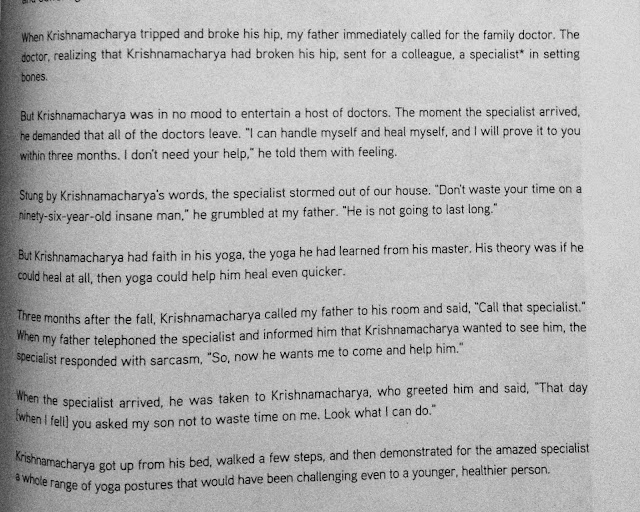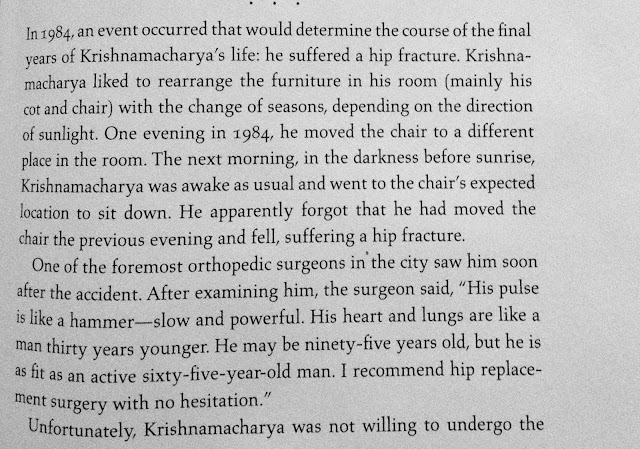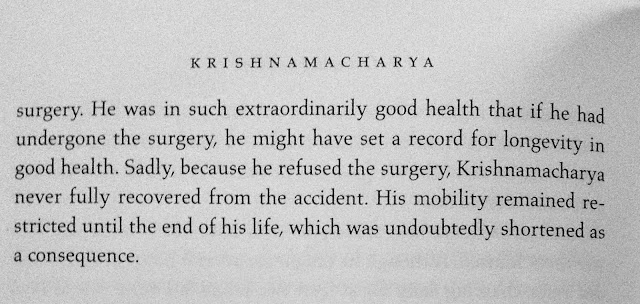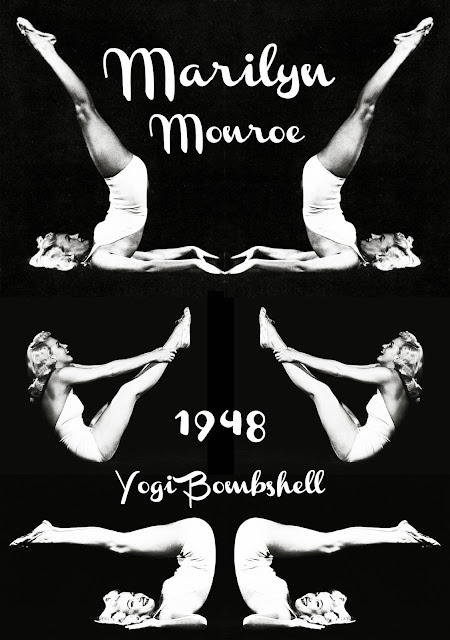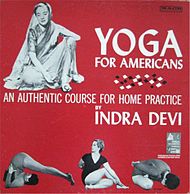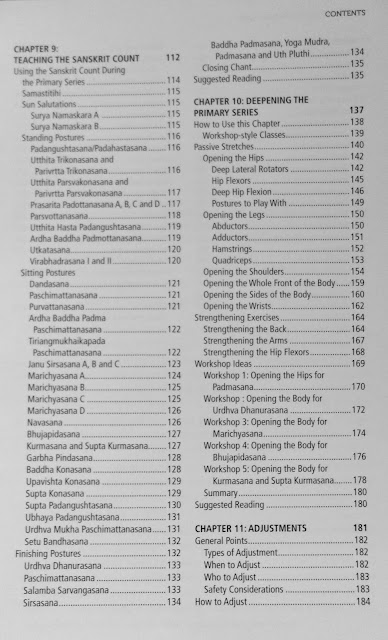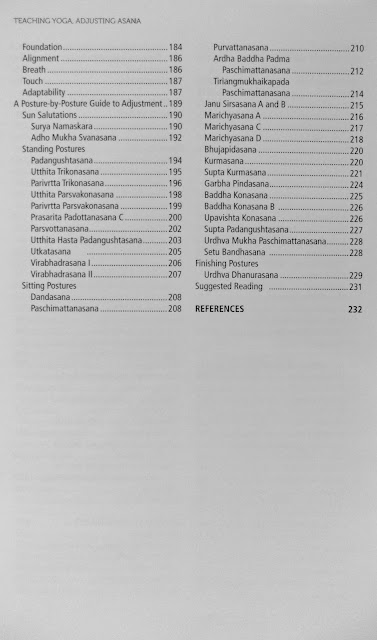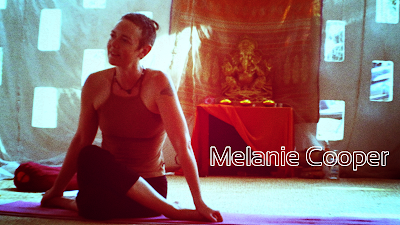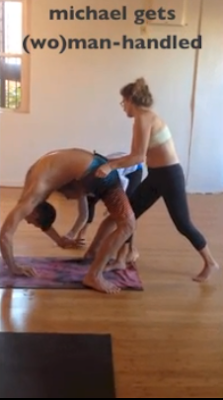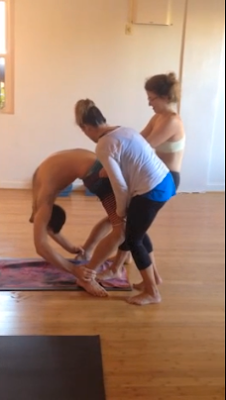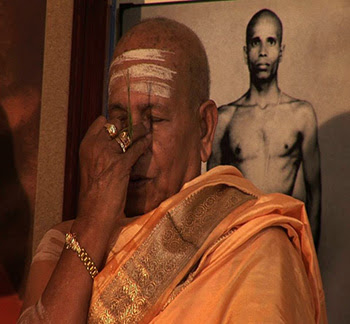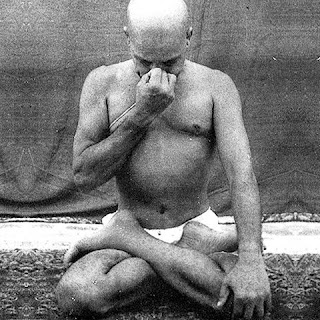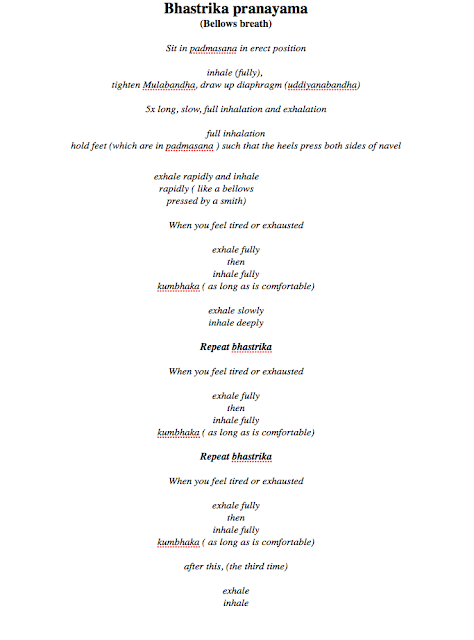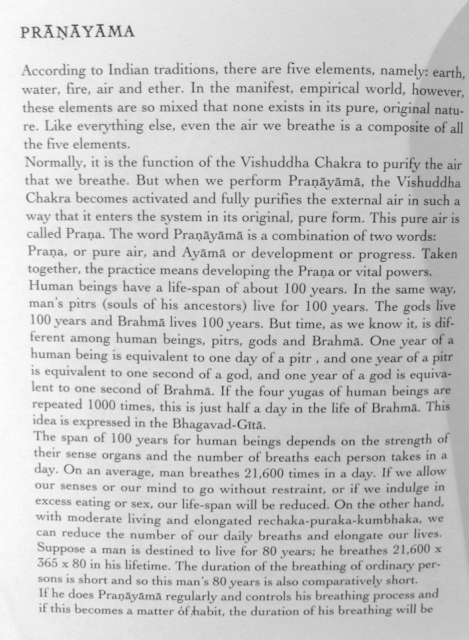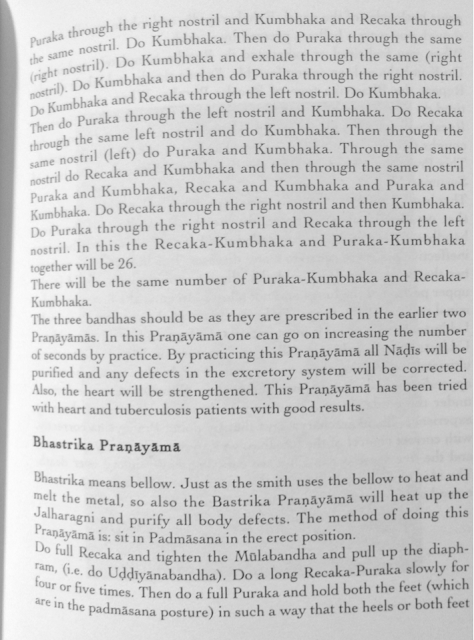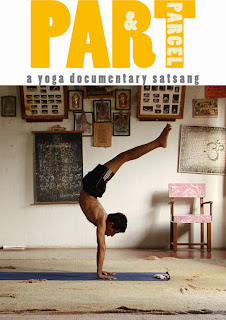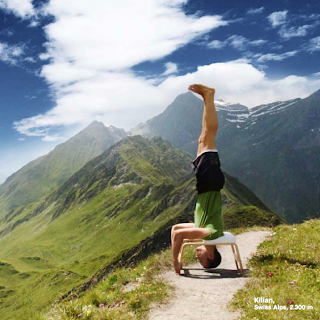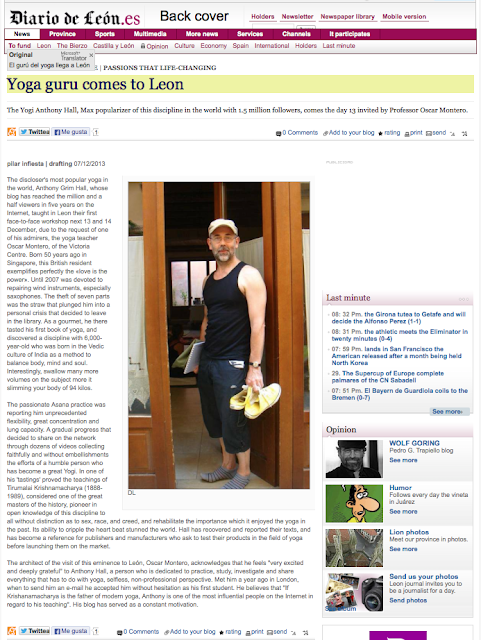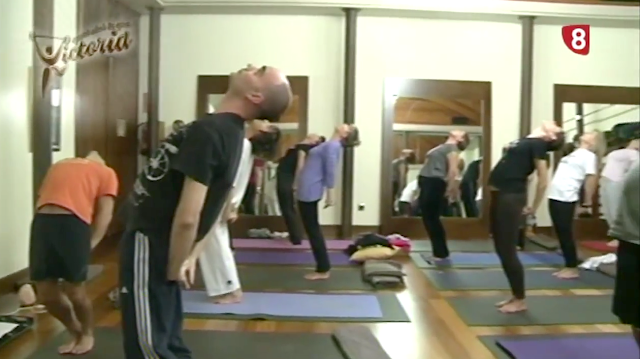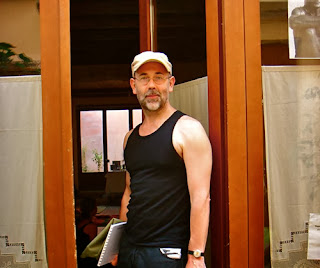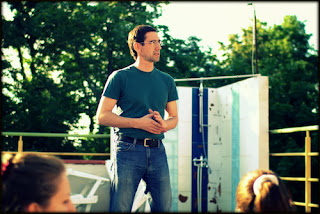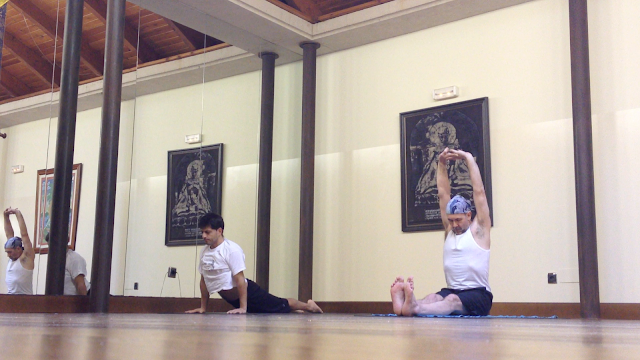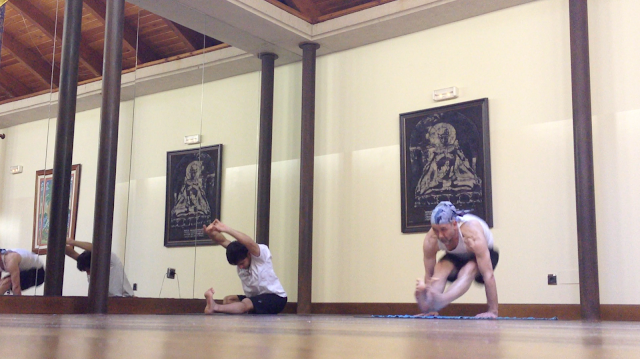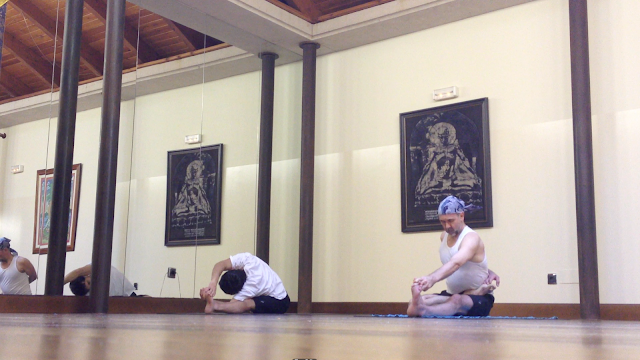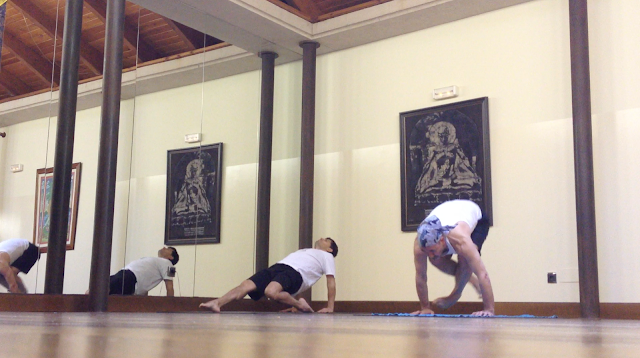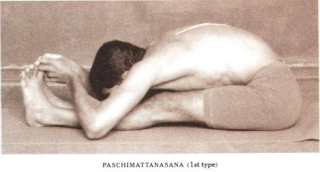Warm Greetings! For 2014, I have three confirmed programs 200 hr TT program at LMU in July/Aug, two week program with Harmony Yoga UK in May/June and a week long program with Yoga Chicago in September. For more details and links to the Yoga schools
I may also be going to Chennai India end December 2013
Virajā
Viraja-- sans rajas and tamas too
My Guru Sri Kṛṣṇamācārya taught chanting and explained the mantras of Mahānārāyana Upaniṣad during my long years of study with him. He taught the Drāvida pātha of this upanishad. I had learnt chanting of the āndhra patha when I was about 12 years old from my father's teacher. Andhra patha is followed by Smārthas to which community I belong and Drāvida Pātha of this upaniṣad is learnt by Vaiṣnavas like my Guru. There are only a few differences between the two versions. Māhānārayana Upaniṣad contains some very important mantras that are used on a daily basis like the prānāyāma mantra, gāyatri āvāhana mantra, several sandhyā mantras and many popular mantras
Sri Kṛṣṇamācārya taught several darsanas or philosophies belonging to the vedas known as āstika darsanas--Yoga, Sāmkhya, vedānta and also nyāya. He also taught mimāmsa to more orthodox students. When he started teaching sāmkhya he mentioned that sāmkhya. yoga and vedānta were āstika darśanas. While we have numerous upanishads in the vedas belonging to the vedānta philosophy, where do we find the tenets of sāmkhya in the vedas.
He referred then to one mantra from the Mahānārāyana Upanishad which can also be found in a few other upaniṣads and other smritis. Succinct and poetic, my Guru used to chant this mantra as the opening prayer while teaching Sāmkhya which runs as follows
अजामेकां लोहित शुक्ल कृष्णां
बह्वीं प्रजां जनयतीं सरूपाम्।
अजोह्येको जुषमाणोनुशेते
जहात्येनां भुक्त भोगामजोन्यः॥
ajāmekāṁ lohita śukla kṛṣṇāṁ
bahvīṁ prajāṁ janayatīṁ sarūpām|
ajohyeko juṣamāṇonuśete
jahātyenāṁ bhukta bhogāmajonyaḥ ||
The mantra in tuṣtup meter (11 syllables per pāda or line) is both profound and poetic and forms the bedrock of the Sāmkhya philosophy. It refers to an entity without a birth(ajā), the prakṛti and with three characteristics represented by three colors, red, black and white. Even as it is unborn (ajā), it produces innumerable offsprings similar in nature (sarūpa) to itself. Then there is another unborn entity (aja) which enjoys or experiences all products of the first ajā or prakṛti. There is another entity which also has no birth (aja) which forsakes all contacts with the products of the fiirst ajā.
The above śloka is given a pictorial representation. The ajā with the three colors is represented as a huge tree and is said to represent the mula prakṛti. The essential constituents of this, represented by three colors actually refer to the three gunas viz, rajas the red, tamas the black and satva the white. This prakṛti tree produces many many fruits which also like the tree have the same essential three characteristics of satva, rajas and tamas. Then there in a bird sitting on a branch of the prakṛti tree and enjoys the fruit made of three gunas. This bird represents the badhha ātma, one representing the vast majority of the beings, especially human beings spending the entire lifetime in bondage with the prakṛti. Then there is another bird even as it sits on one of the branches, refuses to entertain itself with prakṛtic fruits, having experienced the prakriti already and has forsaken all interest in the fruits of prakṛtic tree.. This bird represents the liberated being (muktaātmā) in a state of kaivalya. In a nutshell this vedic śloka tells about the nature of prakṛti and the natures of the soul in bondage and the soul in a state of liberation
According to Sāmkhya the real nature of every being-whether in bondage or liberated is pure consciousness, unchanging and immortal. However due to wrong identification with prākṛtic body arising out of avidyā everyone wallows in prakriti forgetting one's true nature. Sāmkhya and also Yoga urge yogābhyāsi to strive to achieve Kaivalya. Sāmkhya gives the theoretical base and Yoga gives the road map and the necessary tools. The first step would be to reduce the rajas and tamas the red and black strands and make satva the prominent strain of the abhyāsi. It requires some consistent work, Yoga. By āsana and prānāyāma the yogabhyāsi is able to eliminate rajas and tamas making satva to manifest itself as the default characteristic. Thereafter one strengthens the satva with antaranga sādhana or internal practice. When the whole system—what one considers as oneself- made up of the three gunas, the five bhūtas and the ten indtiyas, is cleansed, it become useful for spiritual journey called apavarga. Yamaniyamas also help in the process by preventing the ingestion of rajas and tamas from the outside world.
So the preliminary aim of yoga is to make oneself highly sātvic. Hence old school yoga insisted on doing both āsanas and prānāyāma in tandem.
There is an interesting mantra in the Mahānārāyana Upaniṣad and also in a few other vedic texts called “ātma śuddhi” or Virajā mantras. Again it is a beautiful chant. It is prayer (it is also used as a ritual known as Virajā Homa) to rid oneself (or that one considers as oneself, the physical Self) of rajas and tamas and realize the effulgent Self.
Atma Suddhi Mantras (Self-Purification mantras)
ॐ
प्राणापानव्यानोदानसमानामे शुध्यन्तां ज्योतिरहं विरजाविपाप्मा भूयासंस्वाहा।
वाङमनश्चक्षुश्रोत्रजिह्वाघ्राणरेतोबुद्ध्याकूतिस्सङ्कल्पामे शुद्ध्यन्तां ज्योतिरहं विरजाविपाप्मा भूयासंस्वाहा
शिरःपाणिपादपार्श्वपृष्टोधरशिश्ञोपस्थपायवोमे शुद्ध्यन्तां ज्योतिरहं विरजाविपाप्मा भूयासंस्वाहा।
त्वक्चर्ममांसरुधिरमेधोस्थिमज्जामे शुद्ध्यन्तां ज्योतिरहं विरजाविपाप्मा भूयासंस्वाहा।
शब्दस्पर्शरूपरसगन्धामे शुद्ध्यन्तां ज्योतिरहं विरजाविपाप्मा भूयासंस्वाहा।
पृथिव्यप्तेजोवाय्वाकाशामे शुद्ध्यन्तां ज्योतिरहं विरजाविपाप्मा भूयासंस्वाहा।
अन्नमयप्राणमयमनोमयविज्ञानमयानन्दमयामे शुद्ध्यन्तां ज्योतिरहं विरजाविपाप्मा भूयासंस्वाहा।
विविट्यै स्वाहा
घषोत्काय स्वाहा
उत्तिष्ट पुरुष हरे लोहित पिङ्गळाक्षिदेहिदेहिददापयितामे शुद्ध्यन्तां ज्योतिरहं विरजाविपाप्मा भूयासंस्वाहा।
ॐ स्वाहा
OM
prāṇāpānavyānodānasamānāme śuddhyantāṁ jyotirahaṁ virajāvipāpmā bhūyāsaṁ(g) svāhā |
vānġmanaścakṣuśśrotrajihvāghrāṇaretobuddhyākūtisaṁkalpāme śuddhyantāṁ jyotiraham virajāvipāpmā bhūyāsaṁ(g) svāhā |
śiraḥpāṇipādapārśvapṣṭhodarajaṁghaśiśnġopasthapāyavome śuddhyantāṁ jyotirahaṁ virajāvipāpmā bhūyāsaṁ(g) svāhā |
tvakcarmamāmsarudhiramedosthimajjāme śuddhyantāṁ jyotirahaṁ virajāvipāpmā bhūyāsaṁ(g) svāhā |śabdasparśarūparasagandhāme śuddhyantāṁ jyotirahaṁ virajāvipāpmā bhūyāsaṁ svāhā |
prthivyaptejovāyvākāśāme śuddhyantāṁ jyotirahaṁ virajāvipāpmā bhūyāsaṁ (g)svāhā |
annamayaprānamayamanomyaviġnānamayānandamayāme śuddhyantāṁ jyotirahaṁ
virajāvipāpmā bhūyāsaṁ svāhā |
viviṭyai svāhā|
ghaṣotkāya svāhā |
uttiṣṭha hare lohitapinġalākṣi dehi dehi dadapayitāme śuddhyantāṁ jyotirahaṁ
virajāvipāpmā bhūyāsaṁ(g) svāhā |
oṁ(gm)svāhā||
This prayer is for the purification of what one considers as oneself. Paraphrase hereunder
May the five prānas,
prāna, apāna, vyāna, udāna, samāna,
ten indriyas, speech, mind, eyes, ears, tongue, nose, viitality, intellect, intent and resolve,
then the ten parts of the body, head, arms, legs, sides, back, abdomen, thighs, generative organ, anus,
then seven humors, skin,dermis,muscles,blood, fat tissue, bone, marrow,
then the five sensations, sound, touch, form, taste, smell,
then the five gross elements, earth, water, fire (energy), air and ether
and then the five kośas, physical, physiological, mental, intellect and emotional systems be purified,
I (ātman) am the effulgent, may I be rid of rajas/diseases and sins (tamas)
I hail the Lord permeating everywhere, Hail the Lord the Creator
Oh great Lord (Hara), of golden hue and crimson eyes. Arise, keep blessing me with purity. I am the effulgent, may I be rid of Rajas and Tamas
Hail OM
The goal of yoga is firstly to tame raging rajas and the debilitating tamas. The Virajā (meaning without Rajas) mantra has the same goal. So this 2 minute chant can strengthen the yoga practice. Listen to the chant here
Here is the chanting tutorial thanks to my friend Josh Geidel
Some upaniṣads and purānas and smritis give a symbolic representation of Virajā
The Upanishads, focusing on describing the non-material aspects of the Supreme and spiritual truth, especially put emphasis on the great, impersonal Brahman effulgence.
Between the material universe and the brilliant effulgence of the Brahman is what is called the Virajā nadi or Virajā River. It separates the spiritual world and the material world. It is within the confines of the Virajā River that the material manifestation takes place.
The millions of universes in the material creation is on one side of this river , and on the other are the spiritual space and worlds that float within the Brahman effulgence. The Virajā River is a marginal position dividing the material and spiritual realms, and is thus not under the control of the material energy. When one wades through the preliminary yoga practice one is said to swim through Virajā River shedding the Rajas and the Tamas. After this one is satvic and is ready really ready for the spiritual world.
Between the material universe and the brilliant effulgence of the Brahman is what is called the Virajā nadi or Virajā River. It separates the spiritual world and the material world. It is within the confines of the Virajā River that the material manifestation takes place.
The millions of universes in the material creation is on one side of this river , and on the other are the spiritual space and worlds that float within the Brahman effulgence. The Virajā River is a marginal position dividing the material and spiritual realms, and is thus not under the control of the material energy. When one wades through the preliminary yoga practice one is said to swim through Virajā River shedding the Rajas and the Tamas. After this one is satvic and is ready really ready for the spiritual world.
The mantras are also used in a final fire ritual when one takes to sanyas, renouncing family life and joins the fourth āśrama or sanyāsa āśrama in pursuit of the spiritual realm. The subject renounces every possession and attachment and the rajas and tamas associated with the earlier stages of life. It is known as virajā homa.
Patañjali uses the term apavarga for the process of roll back of the cittavrittis resulting in nirodha. A clear satvic mind goes through the process of apavarga. Sāmkhya Kārikā explicitly mentions the paths that may be taken by a satvic person, as detailed below
Those who follow dharma (order and law), who are wise (jnāna), who are dispassionate (virāga) and/or have siddhis (extraordinarily capable) are said to have a satva buddhi (intelect). Buddhi is like a plow (plough) used by a farmer to cultivate land. Buddhi is sharp when it is satvic. A sharp intellect prepares (adhyavasāya) the field of experience (kṣetra). However if and when it is tamasic it is the exact opposite, chaotic (adharma), non discriminating (ajnāna), addicted (rāga) and slavish (anaiśvarya). Yoga first makes one satvic. What do I do with a satvic mind? Yoga for kaivalya
I belong to this Universe
I am part of this Universe
In one part, Earth, the World
I love my world
I am a citizen of the world.
During nervous insomnious nights
I gaze at the skies for UFO.s
That may bring in aliens from
Other parts of my Universe
I want my world be free of aliens
I belong to this world
I am part of the world
In a part that is my country
I love my country
I do not let aliens
From other parts of the world
To settle in my country
Except when they are
Useful to my country
I belong to my country
I am part of my country
In a part called my Home.
I love my home.
I do not let strangers
Into my home
Nor let neighbors throw
Garbage into my home space
I belong to my home
I am part of my home.
An individual part of my family
I love my family
My spouse, my children
But I keep my space
I belong to my family
I am part of my family
An individual part
Separate and distinct
Sometimes I find it
Difficult to be part of the family
I look at so many people
Leave their family
Letting the spouse and kids
fend for themselves
I am alone by myself
Occupying about 3 cft of space
And about 140 lbs of matter
Out of this huge universe
I love myself
I take care of myself
Like everyone else
But still when some get sick
And depressed and feel pain
Even think of taking their lives
To spare themselves of the pain
So much one loves oneself
As I love myself
So I should know
Who I am with whom I am
In so much of Love
Then I read Yoga Sutras
Then pancha kosa vidya
Of Taittiriya Upanishads
Oh yes
I am not the physical Body
I can see and experience that
Because, I can not experience myself
I am not the physiological body
I am not the body of senses
Nor the subsystem of intellect
Nor the dominating ego
Because I am aware of all of them
I am not any part of whatsoever
I had considered to be myself
I am the one that is aware of all these
I know now that I am not
Any part of what I had
Thought to be myself
I am pure unwavering consciousness
The subject that
Experiences all
That is not I
I am free
Always free
Alak niranjan like
Every conscious being
I am no part of this universe
I do not belong to this Universe
...During early days of my studies with my Guru, one day as I was lying in savasana after an intense asana practice, Sri Krishnamacharya said something on these lines “You can run away from the world, you can go to the Himalayas and become a recluse. But you can not run away from yourself. You have to bring yourself under control and take charge of yourself. Yoga helps one achieve this, admirably”
Sincerely
Srivatsa Ramaswami
*
Links
To this newsletter
https://groups.google.com/forum/?hl=en#!topic/vinyasa-krama-announce/NKXLGkoEX1kRamaswami's Newsletters
https://groups.google.com/forum/?hl=en#!forum/vinyasa-krama-announce
Vinyasa Krama Main page
http://vinyasakrama.com/?q=index.aspx
Ramaswami / Vinyasa Krama Resource page



